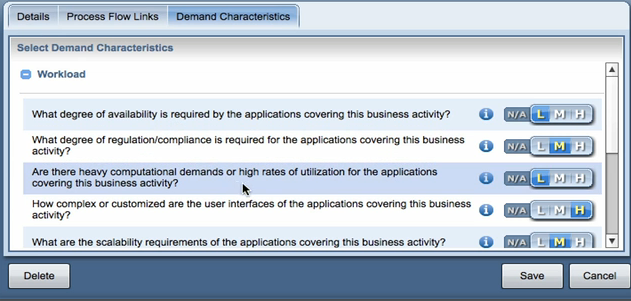Reduce legacy application costs 28% by moving workloads into the cloud.[1] That sounds like a lot of motivation to move to me. So, how to determine which workloads are right for the cloud? How do you decide which ones would benefit most, and which deployment model is best – public, private, or hybrid cloud?
Workload evaluation has two key components – suitability evaluation and placement identification. Suitability looks at the business requirements and technical feasibility of moving applications to the cloud, while placement validates detailed technical requirements of possible cloud architecture models.
In determining suitability, you need to ensure that a migration to cloud will meet or exceed all business requirements. First look at how applications are aligned to specific business processes so you can determine the business impact of moving them. Capture business demand drivers to quantify the functional requirements of applications. Look at specific business activities to correlate applications along your business value chain. Determining cloud suitability also requires the analysis of some technical application attributes, such as code rewrite complexity, security environment, development language, number of users, and business relevance.

Analyze various business demand drivers to determine application functional requirements.
In determining cloud placement, a key initial step is to classify each application by type. Examples include business intelligence, unified communications, operations and manufacturing, and e-commerce. The behavior patterns of these application types drive the technical design characteristics for cloud placement.

The selection of application type drives the determination of technical design characteristics for cloud placement.
During placement analysis, technical workload characteristics such as development language and migration complexity should be looked at in greater detail. You also need to validate the application’s current and projected infrastructure consumption based on business demand so that you can forecast cloud capacity requirements.
When determining suitability, you need to consider a number of application criteria such as age, technical characteristics, business service requirements, user demographics, and application type. Also, think about the degree of availability required for the workload and its data retention requirements. You then need to evaluate these data points against a range of cloud platforms, create a logical application deployment topology, and generate a bill of materials for your cloud deployment.
However, don’t let this seemingly complex analysis slow your motivation. At EMC, we use our Adaptivity platform to rapidly accelerate analysis. This approach is 50% faster and requires 75% fewer resources than typical brute-force, manual approaches. Our platform contains a knowledgebase of application attributes and characteristics of multiple public and private cloud architecture options, such as VMware vCloud Hybrid Service (vCHS), on-premise private clouds, or hosted cloud managed by a vendor like Rackspace. This accelerates the understanding of a workload.
We can dynamically create a dashboard with real-time analysis of application data. Instead of fumbling with spreadsheets, our consultants can get to the right answer in a timely manner.

EMC’s Adaptivity platform dynamically generates a real-time analysis of the application data.
My colleague just recorded this demo which further shows how we use the platform to analyze workloads for cloud suitability and recommend placement in the right cloud model; public, private or hybrid cloud.
Sound intriguing? Chat with us or get more info here.
[1] IDC Research http://present.knowledgevision.com/account/01623/assets/attachment/EMC_Legacy_Cloud.pdf
